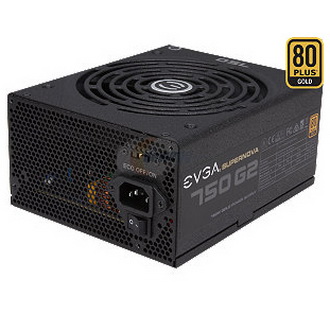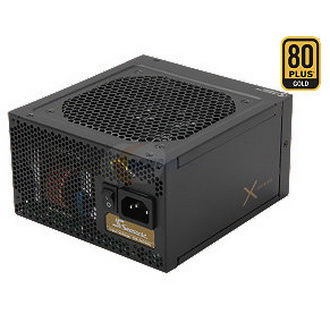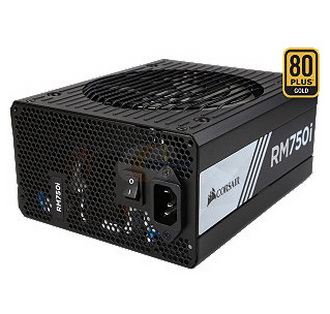Cooler Master V750 PSU Review
Cooler Master recently updated its lower-capacity V series, and today we take a look at the V750. This unit features 80 PLUS Gold efficiency, fully modular cabling and very small dimensions, which put it up against the SilverStone ST75F-GS V2.
Why you can trust Tom's Hardware
Load Regulation, Hold-Up Time And Inrush Current
To learn more about our PSU tests and methodology, please check out How We Test Power Supply Units.
Primary Rails And 5VSB Load Regulation
Load Regulation testing is detailed here.
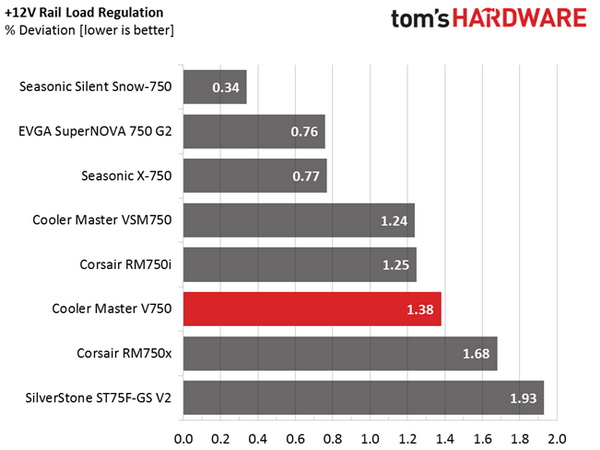
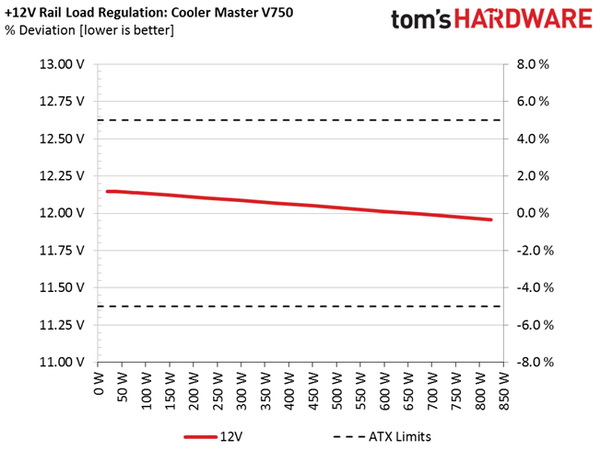
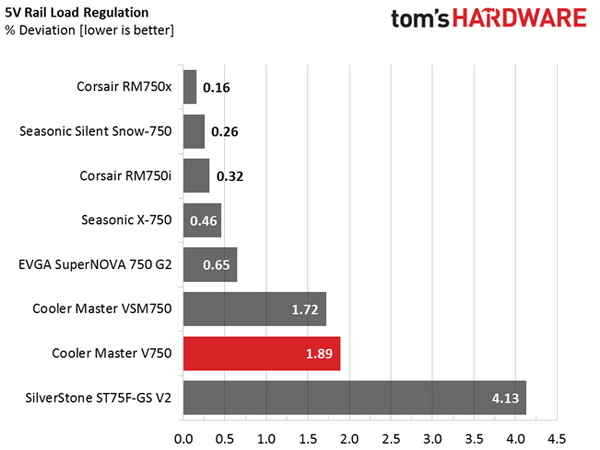
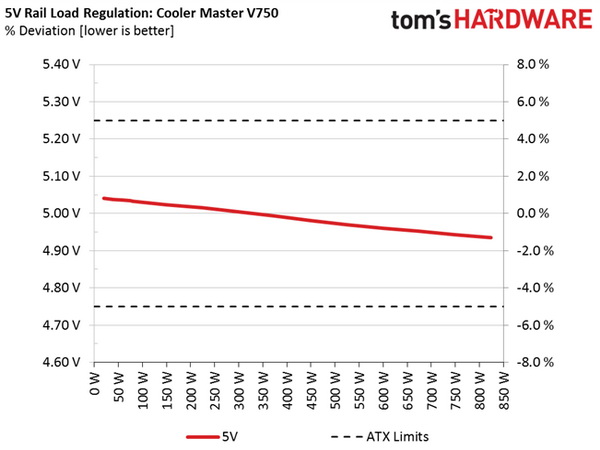
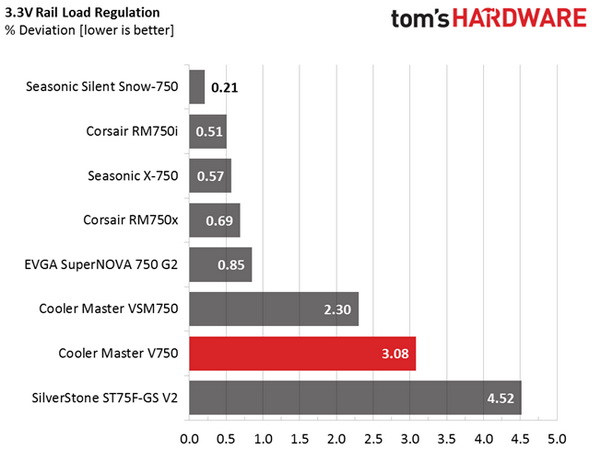
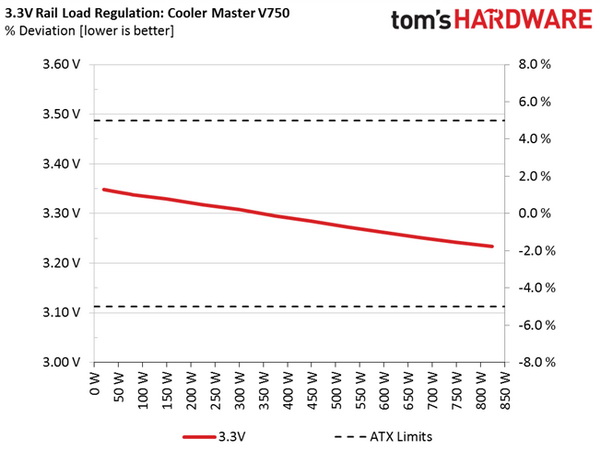
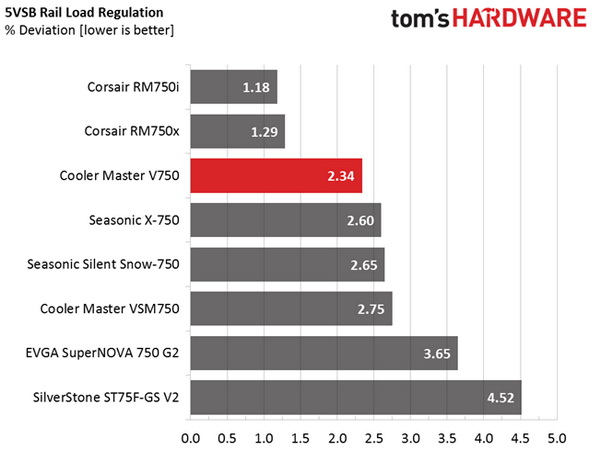
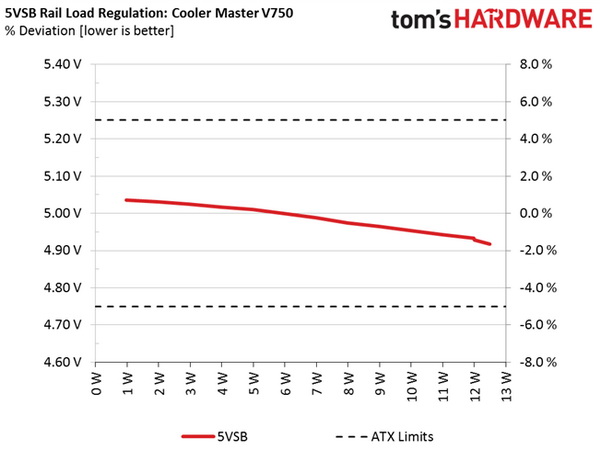
Hold-Up Time
Our hold-up time tests are described in detail here.
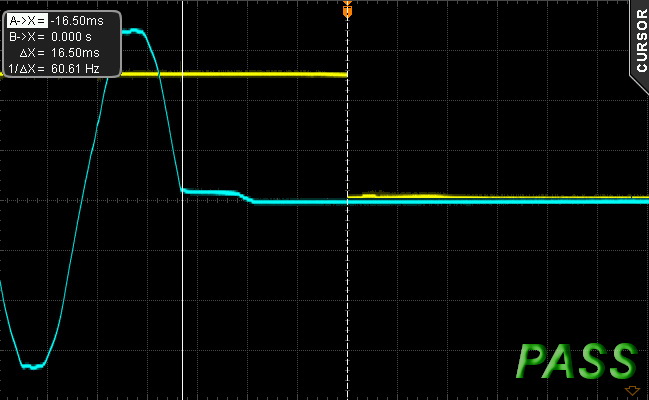

The hold-up time was more than 16ms, so everything was good there.
Inrush Current
For details on our inrush current testing, please click here.
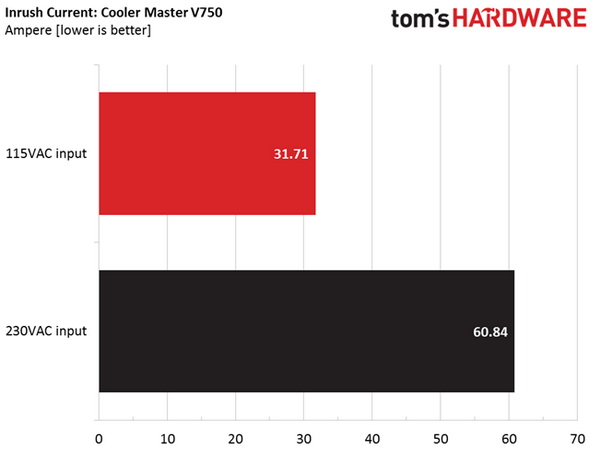
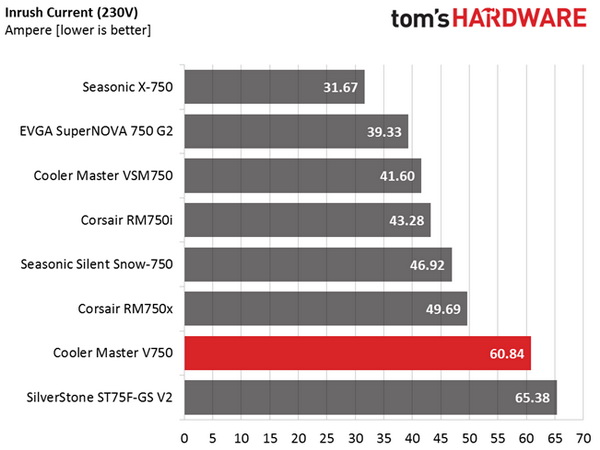
The inrush current with 115V wasn't so high. However, we cannot say the same for 230V, where it exceeded 50A.
Load Regulation And Efficiency Measurements
The first set of tests reveals the stability of the voltage rails and the PSU's efficiency. The applied load equals (approximately) 10 to 110 percent of the maximum load the supply can handle, in increments of 10 percentage points.
Get Tom's Hardware's best news and in-depth reviews, straight to your inbox.
We conducted two additional tests. During the first, we stressed the two minor rails (5V and 3.3V) with a high load, while the load at +12V was only 0.10A. This test reveals whether a PSU is Haswell-ready or not. In the second test, we determined the maximum load the +12V rail could handle with minimal load on the minor rails.
| Test | 12V | 5V | 3.3V | 5VSB | Power(DC/AC) | Efficiency | Fan Speed | Fan Noise | Temp(In/Out) | PF/AC Volts |
|---|---|---|---|---|---|---|---|---|---|---|
| 10% Load | 4.380A | 1.984A | 1.975A | 0.994A | 74.73W | 86.34% | 585 RPM | 27.9 dB(A) | 38.57°C | 0.964 |
| 12.139V | 5.034V | 3.339V | 5.010V | 86.55W | 43.24°C | 115.1V | ||||
| 20% Load | 9.805A | 2.979A | 2.971A | 1.198A | 149.70W | 89.72% | 695 RPM | 31.9 dB(A) | 39.65°C | 0.974 |
| 12.122V | 5.023V | 3.329V | 4.999V | 166.86W | 44.92°C | 115.1V | ||||
| 30% Load | 15.593A | 3.490A | 3.493A | 1.400A | 224.81W | 90.58% | 890 RPM | 28.8 dB(A) | 40.17°C | 0.978 |
| 12.104V | 5.015V | 3.318V | 4.988V | 248.19W | 45.66°C | 115.1V | ||||
| 40% Load | 21.391A | 3.994A | 3.988A | 1.604A | 299.69W | 90.73% | 1300 RPM | 33.5 dB(A) | 41.41°C | 0.983 |
| 12.086V | 5.005V | 3.308V | 4.974V | 330.32W | 47.09°C | 115.1V | ||||
| 50% Load | 26.865A | 4.999A | 5.004A | 1.810A | 374.64W | 90.38% | 1605 RPM | 41.6 dB(A) | 42.02°C | 0.987 |
| 12.068V | 4.993V | 3.295V | 4.964V | 414.51W | 47.89°C | 115.1V | ||||
| 60% Load | 32.355A | 6.021A | 6.026A | 2.016A | 449.65W | 89.46% | 2230 RPM | 47.1 dB(A) | 43.16°C | 0.990 |
| 12.050V | 4.981V | 3.285V | 4.953V | 502.63W | 49.41°C | 115.1V | ||||
| 70% Load | 37.865A | 7.036A | 7.056A | 2.224A | 524.57W | 89.04% | 2230 RPM | 47.1 dB(A) | 43.61°C | 0.991 |
| 12.030V | 4.970V | 3.273V | 4.942V | 589.11W | 50.22°C | 115.1V | ||||
| 80% Load | 43.384A | 8.065A | 8.093A | 2.430A | 599.52W | 88.21% | 2230 RPM | 47.1 dB(A) | 44.79°C | 0.992 |
| 12.012V | 4.960V | 3.262V | 4.933V | 679.67W | 51.72°C | 115.1V | ||||
| 90% Load | 49.352A | 8.579A | 8.642A | 2.434A | 674.56W | 87.44% | 2230 RPM | 47.1 dB(A) | 45.65°C | 0.992 |
| 11.995V | 4.953V | 3.251V | 4.928V | 771.43W | 52.95°C | 115.1V | ||||
| 100% Load | 55.290A | 9.099A | 9.161A | 2.540A | 749.37W | 86.65% | 2230 RPM | 47.1 dB(A) | 46.41°C | 0.993 |
| 11.977V | 4.943V | 3.242V | 4.917V | 864.82W | 53.95°C | 115.1V | ||||
| 110% Load | 61.640A | 9.118A | 9.183A | 2.545A | 824.28W | 85.79% | 2230 RPM | 47.1 dB(A) | 47.82°C | 0.994 |
| 11.958V | 4.935V | 3.234V | 4.909V | 960.85W | 56.05°C | 115.1V | ||||
| Cross-Load 1 | 0.101A | 14.020A | 14.005A | 0.004A | 117.63W | 82.36% | 1770 RPM | 43.0 dB(A) | 43.46°C | 0.974 |
| 12.140V | 5.006V | 3.299V | 5.114V | 142.83W | 49.07°C | 115.4V | ||||
| Cross-Load 2 | 61.941A | 1.003A | 1.003A | 1.002A | 754.71W | 87.22% | 2230 RPM | 47.1 dB(A) | 45.83°C | 0.994 |
| 11.971V | 4.966V | 3.271V | 4.940V | 865.30W | 53.19°C | 115.1V |
Load regulation isn't tight enough to meet the high-end competition in this category. However, it's significantly better than the performance of SilverStone's ST75F-GS V2, which shares the V750's dimensions. The previous-gen VSM750 offers slightly better load regulation on the +12V, 5V and 3.3V rails, which can be explained by its lower-resistance semi-modular design. In the efficiency section, the V750 easily cleared out the 80 PLUS Gold requirements with 20 percent and 50 percent load and was very close to 87 percent under full load. Given that 80 PLUS conducts its tests at a much lower ambient, we will give the V750 a pass.
The LDB fan was silent enough up to the 40 percent load test. Under 20 percent of the PSU's maximum capacity, we noticed a weird increase in noise that likely has to do with a bearing noise or vibration. With typical and higher loads, the fan speed increased quickly, hugely affecting the output noise. This is why Cooler Master rates this PSU at up to 40 °C for max power output and not at 50 °C. The platform can handle increased heat, but the aggressive fan profile makes it loud when the ambient temperature gets too warm.
Current page: Load Regulation, Hold-Up Time And Inrush Current
Prev Page A Look Inside And Component Analysis Next Page Efficiency, Temperature And Noise
Aris Mpitziopoulos is a contributing editor at Tom's Hardware, covering PSUs.
-
Nuckles_56 I couldn't see it mentioned, but could any of the other cables be plugged in where they shouldn't be?Reply -
Giannis Karagiannis But then again with a wire cutter and a little bit of insulating tape everything is possible... :PReply -
Gam3r01 I think TH reviews should take a bit from Jonnyguru or similar and include a point scale at the end. Sure listing the pros and cons with a verdict is enough in most cases, but its up to the reader to decide just how good or bad a unit may be.Reply -
Aris_Mp I agree with you on this, however on page #9 among others you will find a performance graph which can easily play the same role. On top of that it offers comparison data including relevant offerings so a reader can easily figure how the product fares against the competition.Reply -
Gam3r01 While that is included, it dosent give an overall final score. Saying the RMx scored 9% higher is alot different to readers than saying the RMx got a 9.8/10 for ecample.Reply -
SamSerious Point Scales are horrible and i am glad that TH is one of the few remaining sites not to do so. There are already enoguh websites and magazines for people who prefer points, and stars over content.Reply
